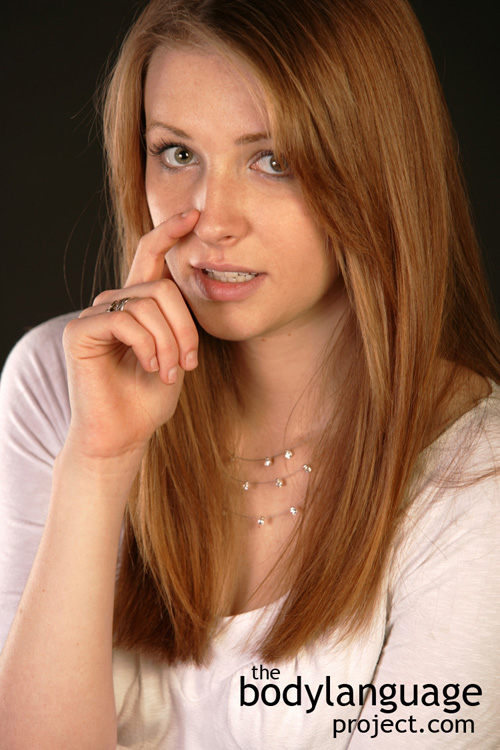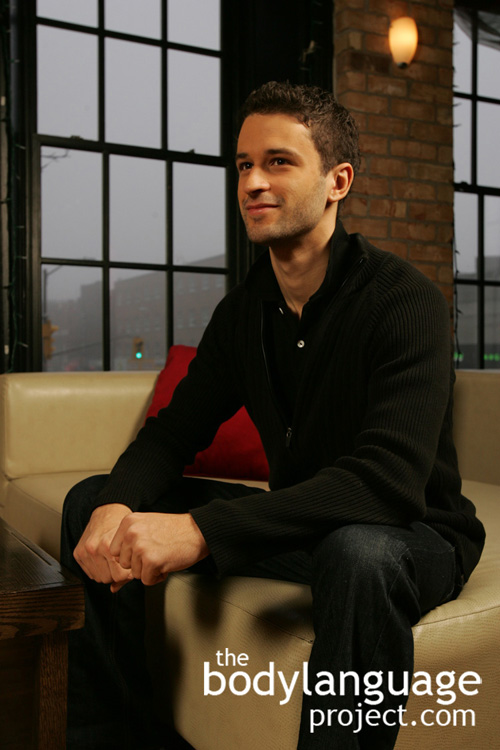
Covering the suprasternal notch is one of the nonverbal signals that is unmistakable and also reliable in predicting emotional distress, one that shouldn’t be ignored.
The neck is an area that becomes particularly sensitive under pressure and like the cheeks, it becomes red and engorged with blood when we become nervous. Women are particularly prone to bringing their hand up to the “suprasternal notch” which is the dimple just below the neck between the Adam’s apple and the breast bone when nervous, distressed, threatened, insecure, fearful or uncomfortable. Covering the suprasternal notch is one of the nonverbal signals that is unmistakable and also reliable in predicting emotional distress, one that shouldn’t be ignored.
While touching the neck and nose can be the result of fear or nervousness they can also be meant as pacifying behaviours. Pacifying behaviours happen automatically, our brains send a message to our bodies that we need to be pacified and out go our hands to serve the purpose. As always, it is important to decide what kind of emotion has demanded the body language, be it nervousness as a result of sweating (discussed below), or because there is an underlying threat causing fear that requires soothing.
Motioning toward our neck, scratching it, or pulling at a collar indicates we are “getting hot under the collar.” Humans sweat in response to external temperature increases but also due to emotional stress. In the case of emotional sweating, it is mostly restricted to the palms, soles of the feet and forehead. However, when we become emotionally aroused our metabolic rate revs-up and we burn more calories. This creates not just local sweating, but sweating throughout the body. Those under pressure can be seen sweating voraciously under the armpits and down their backs even leaving visible stains. Scratching the palms, in particular, has been shows to be a reliable indicator of stress but so too is scratching the neck. Scratching is in response to the tingling sensation we feel on our necks as the sweat increases and uncomfortable chaffing begins between tight collars and the skin. While some experts purport that sweating can indicate lying, it’s actually a signal of frustration and heightened emotion in response to pressure, and that this pressure can stem from anything, including simply being “put on the spot.”
Our noses can also signal stress, but more often signal disgust. The nose is full of blood vessels so when we are stressed they fill up with blood just like the ears and neck. A person under stress will frequently go to their nose and touch it, scratch it or rub it. Touching the nose has been linked to lying, but like most lie detection cues, they aren’t absolute or reliable. We can tell when something is out of the ordinary when someone touches their nose for no reason. They might wipe it with the back of their hand or come up and touch it lightly with their index finger. The astute will find it obvious when someone is touching their nose for the purpose of alleviating an itch instead of alleviating a lie (or negative thought). Scratching is directed, specific, deep and vigorous, showing that some amount of waiting was done before the gesture was performed. Thus more relief is present when the itch is real. Itching due to negative emotions is general, shallow or glancing. This type of itch is done by bringing the index finger up, by example and lightly touching the side of the nose where the nail is not used at all. That is no real scratching is taking place.
Have you ever noticed how infrequently politicians touch their faces while in public and when they absolutely have to, they make it look deliberate and minimal? They raise just one finger and scratch a specific area, than they bring their hand back to their sides or use their hands to liven their speech. When trying to appear honest, we should follow their example. Keep face touching to a minimum, use it specifically, use the nail of the finger to show purposeful itching, and when finished resume normal open and honest gesturing.
When ready people for honesty, be careful not only to watch for cues, but also be watchful of cues that should be present, but aren’t. For example, if someone is describing emotional stress, they should exhibit classic nonverbal behaviours. A woman claiming to have swerved to miss an animal sending her automobile into the ditch should be agitate and on edge, perhaps covering her suprasternal notch as she recounts the details. Failing to exhibit the appropriate cues tells us that she might be trying to pull a fast one on us, perhaps trying to claim insurance so as to benefit from a payout. Looking for cues that should be there, but aren’t, are sometimes cues in and of themselves.








